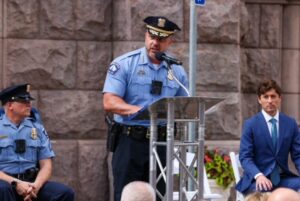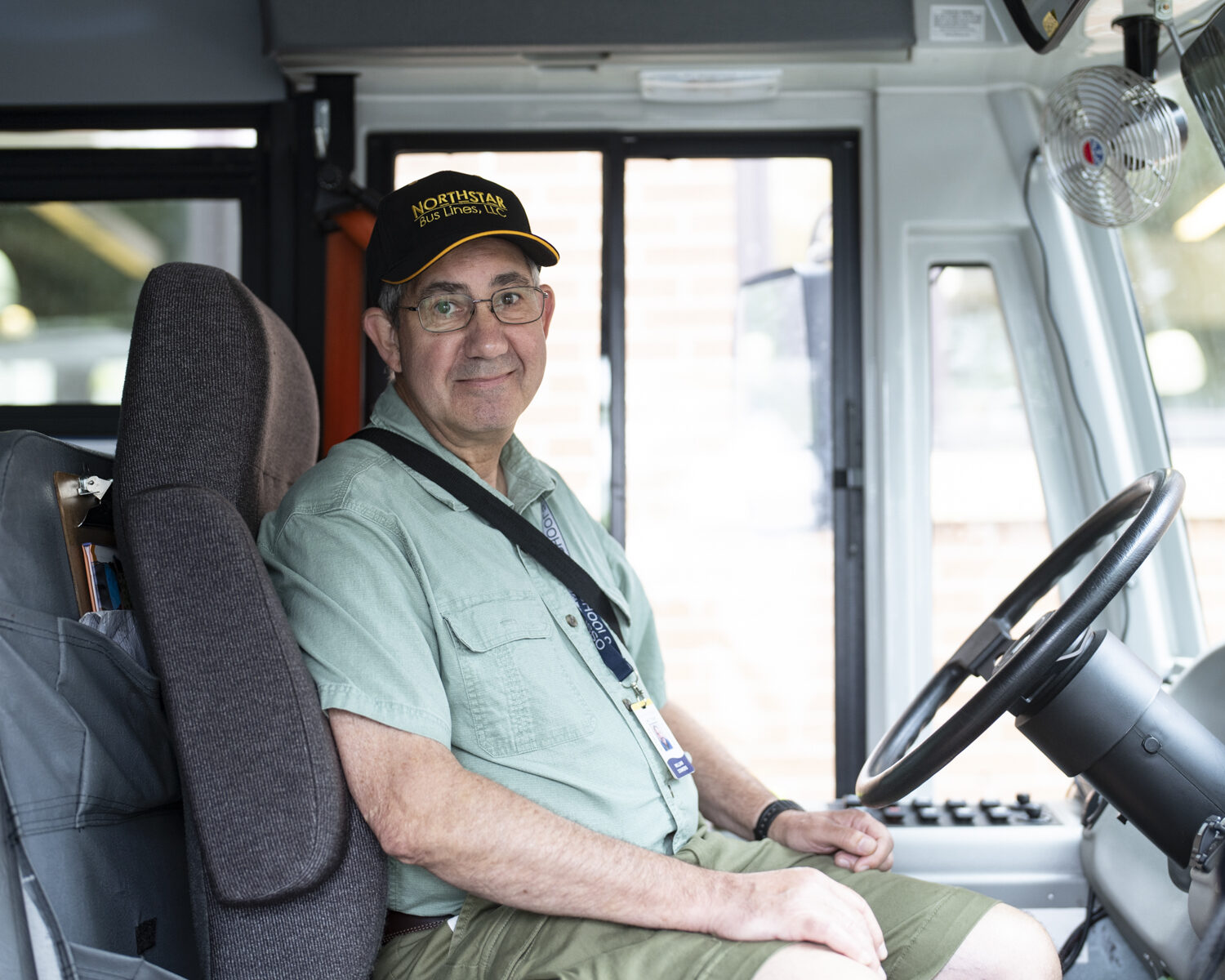BY KAY SCHROVEN
Changes
Ten months into his position as the 54th chief of the Minneapolis Police Department, Brian O’Hara is encouraged, especially about the recent restructuring of the department. He is also acutely aware of the challenges the MPD faces. O’Hara accepted the position knowing he would be walking into the city’s slow recovery from the murder of George Floyd in 2020, the riots that followed, and the COVID-19 pandemic. The mission of the MPD is to reduce serious street crime while rebuilding people’s trust, pride, and the department itself. O’Hara believes the restructuring will support this mission. “We need to move out of the darkness and trauma of the last three years and into a brighter future together,” he said.

Chief Brian O’Hara (Photo/ Minneapolis Police Department)
The recent restructuring is designed to meet the chief’s vision for the department and is aimed at increasing accountability. It took time to create the new structure due to administrative processes, legislative issues and approval required by the City Council. O’Hara sought what the Minneapolis Fire Department has had for a while – a fire chief and five direct reports who have additional staff reporting to them.
MPD’s new organization consists of the chief, two assistant chiefs, five deputy chiefs, and two inspectors for the 2nd and 5th Precincts, Nick Torberg and Christie Nelson. Assistant Chief Katie Blackwell, with 20-plus years on the force, leads the Operations group which is focused on patrols and investigation. Assistant Chief Christopher Gaiters (30 years on the force, 14 in Homicide) leads the Community Engagement and Trust group which consists of three sworn members and approximately 20 paid civilians. His role involves internal affairs and implementing change per the state court-enforced agreement and expected U.S. Department of Justice consent decree. Additional appointments include the following five deputy chiefs:
Jon Kingsbury – Patrol; Jason Case – Investigation; Travis Glampe – Constitutional Policing; DeChristopher Granger – Internal Affairs; and Mark Montgomery – Professional Standards.
O’Hara says that the new structure addresses gaps and creates a better channel for accountability. The structure had been bottom heavy, and O’Hara needed executive level leadership in order to increase accountability. Now the structure is similar to that of other large cities, especially those under consent decrees. O’Hara views the restructuring as part of the needed culture change.
The new leadership includes nine veterans of the MPD. There has been criticism from the community with respect to some of the choices because of their records, which include complaints against them. In addition, there are community members who continually oppose adding staff (top down) at the higher levels rather than bottom-up additions. One popular suggestion is to use some of the $19 million of public safety funding (signed into law by Gov. Walz) to hire community ambassadors to actively engage with communities, especially those most troubled, to gather ideas on services and their delivery. These ambassadors would serve as liaisons and point persons for the police in an effort to support the mission and increase trust between the police and the communities they serve.
O’Hara says that “morale on the force is challenging.” Those officers who remain after the exodus that began in 2020 are tough and have been through a lot, as have the communities they serve. Officers face a broadly brushed, negative view of the police among some community members. This impacts them. They need support, including having the community work with, not against them. Given what Minneapolis has been through it will take time to establish trust.
Community meetings
On Wednesday, Sept. 6, the ninth and final community meeting (per the agreement) was held at Plymouth Congregational Church on Nicollet Avenue. The evening included free pizza, a presentation, and an opportunity for attendees to discuss and give input on the topics addressed in the presentation, including MPD’s mission, values and goals. Suggestions and comments were written and collected at the end of the session. Chief O’Hara was in attendance along with several officers, DeYoung Consulting Services representatives, Raj Sethuraju, professor of criminal justice at Metro State University, and a room full of community members. The overall message was “change is slow and requires community involvement.” Commander Yolanda Wilkes, who has a lead role in the implementation of the agreement, handled much of the presentation. In closing she informed the community that there will be more sessions scheduled in the future for culturally specific groups.
Recruiting and retention
It’s no secret that recruiting officers is an issue across the country. In Minneapolis there has been a 34% decline in the police force since 2018, according to the DOJ. Why is it so difficult to recruit and hire police officers? The are multiple reasons, including the vetting process, which is rigorous and can take months, even a year. Background checks often involve employment history, character references, academic records, residency history, physical ability, polygraphs, and criminal and credit checks. Approximately one out of every 10 applicants makes it through and becomes a viable candidate. Add to this the negative public opinion and scrutiny about policing, plus an increase in line-of-duty injuries and deaths, and you have a situation where there are layers of hurdles to overcome for successful recruiting.
O’Hara says he could use 300 more cops today. He came to Minneapolis from Newark, New Jersey, where he was on the police force from 2001-2022. Newark is smaller than Minneapolis, yet has 1,033 sworn officers versus Minneapolis’ 585, nearly twice as many. Newark’s population is 280,888 versus Minneapolis’ population of 425,336, and Newark covers an area of 26.11 square miles while Minneapolis covers 57.49 square miles. Crime rates in Minneapolis are higher than in Newark, especially property crimes, and are considerably higher than the national average.
Generational differences and challenges
Recruiting today is primarily from Gen Z (born between 1997-2012) and millennials (born between 1981-1996) – roughly today’s high school students through those in their late 30s. These generations often have different views of policing than their parents. Their values and expectations are often at odds with policing and they are reluctant to commit to any one employer. Studies indicate that they value work/life balance, flexible schedules, career growth, social responsibility, shared values, meaningful work, skill development, and collaboration, and expect benefits such as health care and assistance with educational costs. Low starting salaries, demanding work schedules including holidays, and the hierarchy of policing itself can be deterrents for them.
O’Hara believes there are career opportunities on the force including educational support that incentivizes careers for those with a true interest in policing. “We have to get the word out, especially to the schools,” he said.
According to the America First Policy Institute (AFPI), success will require changes in what is offered to new recruits and how they are retained. Proposed ideas include increasing the DOJ’s grant funding to assist state and local agencies; providing financial incentives such as sign-on or year-end bonuses; offering educational support; considering part-time shifts; and subsidized child care and parental leave as well as health-related benefits such as fitness memberships. Some policy changes being considered include such things as eliminating the requirement that candidates not have tattoos, and overlooking dated records regarding the use of marijuana. With 23 of 50 states having legalized use, policies are being revisited. The use of web-based recruiting may be better received than traditional recruiting methods. Younger recruits also respond well to online training. Retention could be improved if new recruits came in with realistic views of policing. Perhaps ride-alongs should be part of initial training so that recruits can distinguish real police work from popular television programs such as “Law & Order,” “NCIS” and “Blue Bloods.”
The landscape of policing is rapidly changing. Police chiefs across the country are challenged on many fronts. The experts say that the profession must be rebuilt which will require full commitment from the leaders of cities, counties, states and the federal government. The future will rely less on weapons and more on social skills such as counseling, negotiation and de-escalation rather than force.






















